Isle of Wight deliveries & Collections only

Ophiopogon planiscapus 'Nigrescens' (Black Mondo Grass)
£4.00
Out of stock
🌿 Ophiopogon planiscapus 'Nigrescens' (Black Mondo Grass)
Ophiopogon 'Nigrescens', or Black Mondo Grass, is a bold, architectural ground cover with narrow, jet-black foliage that creates a dramatic contrast in borders, containers, or gravel planting. Though grass-like in habit, it is technically a perennial in the lily family — evergreen, low-growing, and slowly spreading via underground rhizomes. Pale lilac flowers appear in midsummer, followed by small black berries that add seasonal intrigue.
Specifications:
Height: 15–20cm
Spread: 30–40cm
Flowering: July to August 🌸
Position: Full sun to partial shade
Soil: Moist but well-drained; tolerant of clay, loam, or sandy soils
🌿 Note for Isle of Wight planting:
Black Mondo Grass performs well in the island’s mild climate and handles coastal conditions with ease when planted in sheltered spots. It offers excellent contrast against gravel, stone, or pale foliage. In heavier clay areas, improve drainage before planting. This is a low-maintenance choice that delivers high visual impact all year round.
🌿 Ideal Companion Plants for Ophiopogon 'Nigrescens'
1. Geranium 'Rozanne'
The violet-blue flowers and soft habit of Geranium stand out against the black foliage, creating eye-catching colour contrast.
2. Achillea millefolium 'Paprika'
The fiery red blooms of this Achillea variety bring warmth and brightness to the cool drama of Black Mondo.
3. Salvia 'Nachtvlinder'
The smoky purple tones of Salvia echo the dark foliage while introducing height and pollinator appeal.
4. Anemone coronaria 'Lord Lieutenant'
The deep royal blue petals of Anemone pop against the black foliage in spring, creating a dramatic seasonal vignette.
5. Erigeron karvinskianus
The fine, light daisy blooms of Erigeron weave gently around the base of Mondo Grass, softening its bold silhouette.
🌟 The Green Standard Tip:
Use Ophiopogon 'Nigrescens' in bold drifts under silver-leaved shrubs, as edging for gravel paths, or planted in contrast against pale paving. It’s also striking in pots or modern urban gardens.
